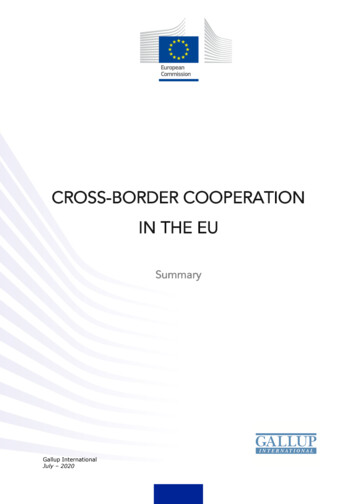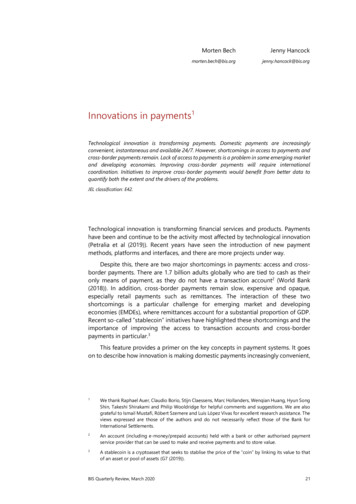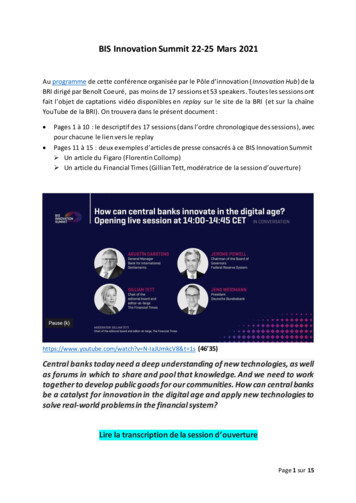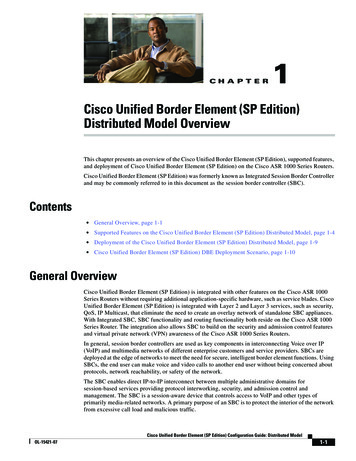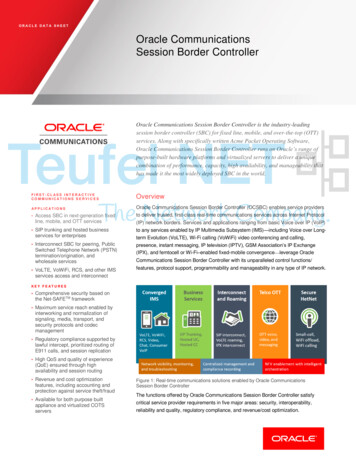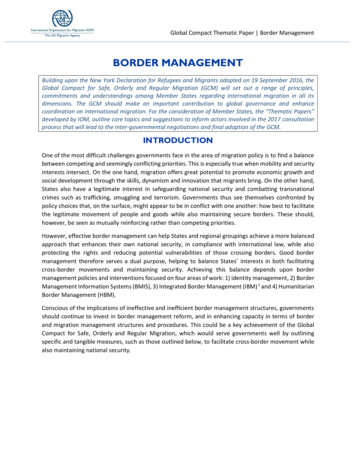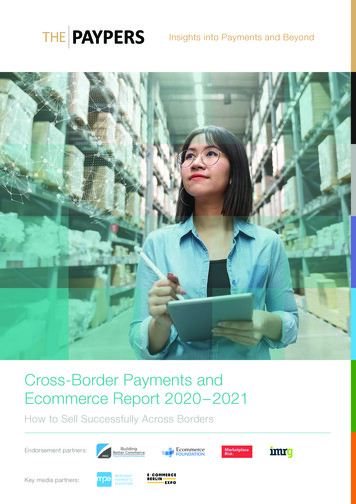
Transcription
Insights into Payments and BeyondCross-Border Payments andEcommerce Report 2020 – 2021How to Sell Successfully Across BordersEndorsement partners:Key media partners:
Cross-Border Payments and EcommerceReport 2020 – 2021How to Sell Successfully Across BordersContact usFor inquiries on editorial opportunities please contact:Email: editor@thepaypers.comTo subscribe to our newsletters, click hereFor general advertising information, contact:Mihaela MihailaEmail: mihaela@thepaypers.comRELEASE VERSION 1.0DECEMBER 2020COPYRIGHT THE PAYPERS BVALL RIGHTS RESERVEDTEL: 31 20 893 4315FAX: 31 20 658 0671MAIL: EDITOR@THEPAYPERS.COM
Management SummaryNowadays, people spend more time than before looking for products online – and by comparing different products or services, they observe thatthere may be other marketplaces or retailers abroad that sell an even nicer, better, or cheaper product than they could find in their home market.At the same time, many merchants see a world of opportunity beyond borders, as the cross-border ecommerce market continues to grow at afast pace and to gain in popularity. Estimates suggest that, by 2027, the global cross-border B2C ecommerce market will reach no less thanEUR 3.9 trillion.Considering the current context, the Cross-Border Payments and Ecommerce Report 2020–2021 is highly relevant for all the players that want togain a comprehensive view of the global payments and ecommerce market. The articles, the interviews, and the research encompassed in ourreport supply a sharp overview of the main challenges and opportunities that might arise when selling across borders. Our key objective is to helpmerchants succeed in expanding globally and growing revenue, by providing information on what it takes to flourish. With that in mind, togetherwith our contributors, we have decided to touch upon trends and topics that are closely related to this market.Intrinsic developments within the industryIn-store retail sales have continuously declined in the aftermath of the COVID-19 pandemic. This change of perspective allowed for an evensteeper growth of the ecommerce industry, and the impact of the crisis upon consumer behaviour cannot be negated. Its effects, it seems, arehere to stay, and in his contribution Jorij Ambraham of Ecommerce Foundation estimates that the industry will see a 40% growth in 2020,compared to 2019, registering one of the most impressive jumps in modern history.Raising the bar in digital shopping services to match consumers’ demandsWorldwide, consumers across different generations changed their buying behaviour, as the lockdown that was in place in many countries forcedthem to reconsider their options and shop online. Therefore, the perfect time for expanding across borders is now! There are many factors thatmust be considered, especially since some of today’s consumers are relatively new to online shopping; but regardless of that, everyone just wishesto have a streamlined shopping experience, an optimised checkout page, virtual consultations, and so on.With retail websites reaching almost 22 billion visits in June 2020 (representing a huge 6 billion increase since January 2020), as the Payvisionteam states, it is vital to make the customer feel like home in the online space. This can be accomplished by personalising the online shoppingexperience as much as possible. Merchants need to localise their content, customise their offers, set up local customer support, or even tailorthe checkout process to the customer’s preferences because a positive user experience is vital – 90% of marketers consider that personalisationis key when it comes to the future of online shopping, with 74% of consumers disliking it when the content is not personalised and 48% ofconsumers admitting that they spend more when their experience is tailored to their preferences.Localising the payments process – by understanding the regional payment preferences of the customers and integrating local payment methodsinto their checkout experiences – is also vital, as Arik Shtilman of Rapyd stresses upon in his article. He also states that, on average, 78% of all onlineshoppers around the globe abandon their carts, and abandonment rates are higher for cross-border transactions. There are other elementsthat should not be treated lightly, such as language optimisation and currency conversion – and by accepting payments in local currencies,businesses can also mitigate the risk of chargebacks. These payment-related steps that need to be taken can be cumbersome for merchants, andthat is why we expect to see even more alliances with modern fintech and ecommerce solution providers that can streamline the process.Another vital aspect is represented by logistics, as some of the main things online and multichannel retailers should consider when sellingacross borders are making sure that the products sold are well-stocked and being able to rely on a speedy delivery service. 3Cross-Border Payments and Ecommerce Report 2020 – 2021 MANAGEMENT SUMMARY
Management SummaryMarketplaces – still on the riseMarketplaces are becoming more and more popular every year, mainly due to the level of trust they provide to the customer and their large numberof products available at great prices. Accordingly, the technologies that have use cases in the ecommerce sector are continuously evolving;therefore, even though relevant developments in this space have been happening for years now, they continue to change in a split second.Most of the marketplaces categories already have established leaders in most regions – such as the US (e.g., Amazon, eBay), China (e.g., Alibaba,JD.com), Europe (e.g., Carrefour, Zalando, Otto), or Africa (e.g., Jumia).Features like shopping assistance, augmented and virtual reality, or voice commerce have a lot of potential and enhance the experience bymaking it more appealing to consumers. Other factors that can make a difference are whether a marketplace is mobile-friendly (considering themillions of smartphone users), whether it offers numerous payment methods (to satisfy all the customers), and whether it has a reviews’ section(which is relevant because customers usually want to check other people’s opinions on certain products or services prior to buying them).We estimate that most of these trends are here to stay, and we expect to see even more developments when it comes to online shopping platforms,in both horizontal and vertical markets.The report’s structureFor this year’s edition of the Cross-Border Payments and Ecommerce Report, we have decided to divide the contributions into five chapters,each representing a main frame of today’s cross-border picture.COVID-19 impact on the global payments and ecommerce spaceThe COVID-19 crisis has a massive impact on all businesses, be it positive or negative. However, even though this situation is unprecedented inthe history of globalised trade, Limonetik argues that the introduction of technological advances and new business models will help businessesrecover and adapt to the new standard. The silver lining is that, as PPRO reinforces, throughout 2020, we have seen an acceleration towardecommerce, and the volume of global cross-border ecommerce grew by 21% in the first six months of this year. Banking Circle talks aboutthe post-pandemic global banking scene, touching upon the important role of financial infrastructure providers, who deliver new technologicalsolutions that play an increasingly vital part in the financial ecosystem, helping banks and payment businesses improve cross-border paymentsfor their clients.Mark Beresford of Edgar, Dunn & Company suggests that cross-border payments are at a new crossroads following COVID-19, and from nowon economies of scale, M&A, cost efficiencies, and new pricing strategies will be the new normal to secure new revenue sources. Joshua Chongfrom Kapronasia adds that when it comes to the actions taken by ecommerce platforms to streamline the process, the sales strategies designedto increase purchase amounts and basket sizes together with new features such as instant delivery (with the goal of improving the consumer’sexperience) are worth mentioning. Therefore, ecommerce posts the best prospects for growth over the next years, while cross-border salesare expected to continue to increase their share, Euromonitor concludes.Taking the pulse of the cross-border ecommerce marketThe cross-border ecommerce space still shows an impressive growth potential, and some of the main aspects that merchants should considerare mobile enhancement, localising the payment and shopping experience, establishing trust, and making use of the latest technological tools.As Lazada displays in this chapter, livestreaming is one such example, representing a new frontier for online shopping, digitalising businesses,creating new jobs, and keeping brands and sellers connected to their consumers. What’s more, according to Euromonitor, a greater focuson virtual brand engagement and the consolidation of the fintech space are also among some of the key developments that are expected totake place in the near future. 4Cross-Border Payments and Ecommerce Report 2020 – 2021 MANAGEMENT SUMMARY
Management SummaryIMRG provides an insightful analysis based on a new index they launched in September 2020, with data from around 200 retailers on theGlobal-e platform – tracking online sales growth from UK retail sites to cross-border destinations. The regional perspective is taken evenfurther by Data Insight’s article, centred around facts and figures characterising the cross-border ecommerce market in Russia.How to succeed in selling across bordersThere are many success stories revolving around selling across borders, and we have some tips and tricks to help merchants navigate these –perhaps – troubled waters. In this chapter, we feature valuable insights from companies such as Cybersource, explaining why some merchantsfound it easier than others to deliver the seamless digital experiences today’s consumers demand. Furthermore, Ixopay elaborates on whyit is relevant to optimise the existing payment strategy prior to expanding in new markets, while Nexway shares insights on how companiesare managing the market disruption, while also remaining resilient during these uncertain times. MRC adds to this picture by discussing theintricacies of cross-border transactions and providing relevant advice regarding acceptance rates and their impact on revenue.Key considerations on cross-border paymentsDuring the last decade, we have been witnessing continuous changes when it comes to the way in which people choose to pay. That is why, in thissection of the report, we decided to take a closer look at the particularities of cross-border payments, emphasising the new developments thatimpact payment preferences across regions and elaborating on what it takes to optimise payments performance when working with multiplePSPs/acquirers.The insights are offered by players such as ACI Worldwide, presenting the payments challenges and trends cross-border merchants need tobe prepared for in 2021 and beyond, Mastercard, touching upon digital payments and the touch-free transaction landscape, and Thunes,revealing the most common payment challenges faced by businesses that start out in emerging markets. Discover Global Networkshares the routes followed by RuPay, a card programme scheme in India, to build up the contactless payments mainstream in the countryand ensure payment innovation and cross-border presence. Trustly completes the picture by elaborating on the rise of online banking e-paymentsacross regions and the main benefits they present. Moreover, Sunil Jhamb of WL Payments explains why payment orchestration is so popularat the moment and shares tips for companies looking to replace their payment platform.Liam Castagna, Head of Payment at Insparx, talks about the importance of having a multi-acquirer setup and shares useful pointers on the relevanceof benchmarking different payment routes, while Dilip Asbe, MD and CEO of NPCI, elaborates on the key developments that can be observedin India’s instant payments space and the urgency in driving financial inclusion and creating an evolved digital ecosystem to cater to the diverserequirements of the Indian population. Another hot topic featured in this chapter is represented by the implications of the European Commission RetailPayments Strategy on cross-border payments in Europe, a subject tackled by Robrecht Vandormael, Secretary General of Payments Europe.Peter Theunis of Radar Payments rounds off the chapter by elaborating on the way in which fintechs have changed the game of cross-borderpayments, with their unbeatable technology.Insights into the thriving marketplaces ecosystemAs online shopping platforms are constantly gaining ground, we found it imperative to take the pulse of the marketplaces sector, including in this sectioninsights provided by prominent industry experts. Luiz Henrique Didier Jr. of Bexs Bank presents the key payment challenges for marketplaces inthe Brazilian market and touches upon the most relevant emerging trends impacting cross-border marketplaces in the region, while Sami Loualiof Jumia talks about the main challenges encountered by African marketplaces when it comes to payments and financial services. The globalperspective is enriched by Floriane Gramlich, Director of Product at Zalando Payments, who shares insights on how to handle friction whileproviding unrivalled user experience in the PSD2 (European) context. 5Cross-Border Payments and Ecommerce Report 2020 – 2021 MANAGEMENT SUMMARY
Management SummaryOther specialists sharing their expert knowledge in this chapter are John Caplan of Alibaba, who explains why it is extremely important to seizethe marketplace opportunity in the B2B segment, Masha Cilliers on behalf of Be Shaping the Future, pointing out why the risk and fraud managementtasks for marketplaces should not be taken lightly, and Vanessa Culver, Senior Manager of Payments at Zillow, who sheds light into how to build astrategy around key payment challenges when it comes to transnational marketplaces.Marketplaces – overview per target audiences and regionsSubsequently, the spotlight is on online shopping platforms. Being driven by the industry’s need for a comprehensive overview focused on marketplaces,we conclude the report with an in-house research, a one-of-a-kind analysis of the players in this space. Considering the diversity of this ecosystem,it was of the utmost importance to classify them by taking into account three pertinent variables: target audience, vertical, and region. The targetaudiences considered are B2C, B2B, and C2C, and the verticals covered are consumer goods and services, food and consumer goods delivery,mobility, hospitality and travel, finance, gig market and recruiting, and education. The infographic features players across all regions (Asia–Pacific,Europe, Latin America, Middle East & Africa, North America), while also including the global ones (those who are present in three or more ofthese regions). With this endeavour, we aim to provide a complete overview of the cross-border ecommerce market, so that our readers gaina better understanding of the diverse players from all over the globe.Our commitmentTo help the players in the cross-border payments and ecommerce industry understand the opportunities that arise, throughout the report weprovide up-to-date perspectives on this environment. The main subjects tackled here are relevant in depicting today’s cross-border ecosystemand in determining the most successful path toward growing an ecommerce business globally.We invite you to explore the Cross-Border Payments and Ecommerce Report 2020–2021 to stay one step ahead in these peculiar times.Enjoy your reading!Raluca Constantinescu Content Editor The Paypers6Cross-Border Payments and Ecommerce Report 2020 – 2021 MANAGEMENT SUMMARY
Table of Contents3Management Summary9COVID-19 Impact on the Global Payments and Ecommerce Space10Future-Proof Cross-Border Banking Anders la Cour, Banking Circle13Key Considerations on Global Trade During the Pandemic Corinne Estève Diemunsch, Limonetik16The Great Digital Shift of 2020 and What to Watch Out for Next Interview with Matthew Jackson, PPRO19Ecommerce and COVID-19 – The Good, The Bad, and The Ugly Interview with Jorij Abraham, Ecommerce Foundation22Cross-Border Payments Are at a New Crossroads Following COVID-19 Mark Beresford, Edgar, Dunn & Company24Cross-Border Ecommerce in the COVID-19 Era and Beyond Cosmin Dan, Euromonitor26Ecommerce in Asia – Lessons Learnt During the Pandemic Joshua Chong, Kapronasia28Taking the Pulse of the Cross-Border Ecommerce Market29Cross-Border Ecommerce in Russia – Facts and Figures Nadezhda Vinogradova, Data Insight31Top M-commerce Trends to Look for in 2021 Kendrick Sands, Euromonitor33How Are Cross-Border Sales Faring for UK Retailers? Andy Mulcahy, IMRG, Neil Kuschel, Global-e37The Transformative Power of the Ecommerce Industry Raymond Yang, Lazada39How to Succeed in Selling Across Borders40Better Customer Experiences Start with Better Merchant Experiences Lee Tango, Cybersource44Why You Should Optimise Your Existing Payment Strategy Before You Expand Interview with Rene Siegl, Ixopay48Resilience Roadmap: Insights for 2021 Planning Victor Iezuitov, Casey Potenzone, Nexway51Taking Your Ecommerce Business Abroad? Here Is What You Should Look At! Payvision542021 Is the Year to Localise and Personalise Your Cross-Border Ecommerce Experience Arik Shtilman, Rapyd57To Be (Domestic) or Not to Be (Domestic), That Is the Cross-Border Question Julie Fergerson, MRC60Key Considerations on Cross-Border Payments61Challenges and Trends Cross-Border Merchants Need to Be Prepared for in 2021 and Beyond Peter Moedlhammer,ACI Worldwide64How Rupay Ensures Payment Innovation and Cross-Border Presence Praveena Rai, NPCI, Discover Global Network67Embracing Change – The Touch-Free Payment Revolution Is Here Keith Douglas, Mastercard71How Fintechs Are Taking Their Stake in Cross-Border Payments Peter Theunis, Radar Payments74Don’t Let Cross-Border Payment Challenges Get in the Way of Doing Business in Emerging Markets Interviewwith Bogdan Dinu, Thunes78The Global Trend Towards Online Banking e-Payments Interview with Mario Klapsis, Trustly81The Importance of Payments Orchestration and Transaction Routing Interview with Sunil Jhamb, WL Payments84Multi Acquirer Setups – Giving Power Back to the Payment Manager Liam Castagna, Insparx86India’s Digital Transformation and the Status of Instant Payments in the Region Interview with Dilip Asbe, NPCI88The Implications of the European Commission Retail Payments Strategy on Cross-Border Payments in Europe Robrecht Vandormael, Payments Europe917The Untapped Potential of Digital Money in Cross-Border Payments and Trading Mirela Ciobanu, The PaypersCross-Border Payments and Ecommerce Report 2020 – 2021 TABLE OF CONTENTS
Table of Contents949599Insights Into the Thriving Marketplaces EcosystemKey Payment Challenges for Marketplaces in the Brazilian Market Interview with Luiz Henrique Didier Jr., Bexs BankSeizing the Marketplace Opportunity: B2B Ecommerce Cross-Border Expansion John Caplan, Alibaba101A Road Map for Selling in Different African Markets Sami Louali, Jumia104Are Risk and Fraud Management Easy Tasks for Marketplaces? Masha Cilliers, Be Shaping the Future106Transnational Marketplaces: Building a Strategy Around Key Payment Challenges for Global Merchants Vanessa Culver,Zillow108110111Getting a Grip on PSD2 – How to Handle Friction While Providing Unrivalled User Experience Floriane Gramlich, ZalandoMarketplaces – Overview per Target Audiences and RegionsIntroduction112Infographic8Cross-Border Payments and Ecommerce Report 2020 – 2021 TABLE OF CONTENTS
COVID-19 Impact on the GlobalPayments and Ecommerce SpaceAs the COVID-19 pandemic brought such a visible briskness in the pace at which technology evolved and consumersshifted to digital, we felt it is paramount to take a closer look at all the ways in which the pandemic impacted the crossborder payments and ecommerce space. Top experts in the field focus on specific contexts such as cross-border banking,global trade, cross-border ecommerce, or put a close lens on regions that showed a particular penchant for digitalisation,such as Asia.
Banking CircleFuture-Proof Cross-Border BankingAbout Anders la Cour: Anders la Cour used his experience in legal M&A venture capital and strongcommercial acumen to co-found Banking Circle in 2013. In 2018 he orchestrated a USD 300 millionmanagement buy-out with EQT and secured a banking licence in 2020. Anders is the inauguralChair of the Emerging Payments Association EU, having been on the EPA Advisory board since2016. He is regularly invited to speak and present at industry events around the world, has wonmultiple awards, and had thought leadership articles published in a range of industry publications.Anders la CourCo-founder and Chief Executive OfficerBanking CircleCOVID-19 has caused financial institutions to rapidly accelerateOf course, by the time the study commenced, our respondentstheir digitalisation strategies. This article touches upon the vital roleand interviewees were staring into a pandemic that was graduallyof digital financial infrastructure in rebuilding international bankingshutting down nations and industries.to stand firm in an uncertain and unpredictable future.Our survey and interviews involved senior executives from a rangeEven before the pandemic plunged businesses of all types intoof financial institutions across Europe. Encouragingly, and ratherunprecedented crisis-mode, banks had been changing. In order tosurprising in the circumstances, feedback showed industry-widecreate more responsive and flexible businesses that centre aroundoptimism for the future – a substantially different picture from a decadecustomers’ requirements and experience, banks have been workingago when the world was in the midst of a very different global financialto change their business practices, their culture, and – most of all –crisis.their technology.The most confident banks we spoke to were those that have alreadyThe banking industry has been tech-heavy for generations, but itsmade heavy investments in their tech stack or re-aligned theirtechnology has not always served it well. The monolithic systemsfinancial infrastructure to use third-party services in response toand in-house servers on which banks are built have held themchanging demand. Less than a third of financial institutions are nowback from competing with the agility of new entrants, so they haveconcerned about the pace of technological change in banking –not kept up with the pace of change in other industries. The once-dropping to one in six among commercial banks.pioneering systems pose a significant challenge for banks deployingnew software and applying best practices, especially when it comes90% of institutions reported that they are building technologyto cross-border transactions. And that’s before you factor in a globaldesign and architecture into their business planning. 80% of retailpandemic.banks and 74% of commercial banks have already worked withinfrastructure providers.In March 2020, Banking Circle carried out a study into how financial10institutions in Europe were developing digital strategies. When thisThe cross-border conundrumstudy was initially planned, the term ‘COVID-19’ didn’t yet exist, soOne area in which incumbent banks struggle to compete with fin no one could have predicted that the timing would allow us to gaintechs is international transactions. Using the correspondent bankingsuch a unique and valuable snapshot into business confidence.network, cross-border payments are slow and expensive. Cross-Border Payments and Ecommerce Report 2020 – 2021 COVID-19 Impact on the Global Payments and Ecommerce Space
In a competitive, fast-paced, digital, and international market, thePost-pandemic global bankingdelays in cash flow and the high cost of cross-border transfers2020 has not provided the clarity it seemed to promise, with itswaste resources and limit growth. With businesses around theconnotations of clear vision and perfect eyesight. The rapidlyworld currently operating on tighter margins and often with a smallerchanging landscape and the widespread uncertainty have cloudedworkforce, they cannot afford to waste that time or money.our view of the future. However, it is exciting and encouraging tosee the increasing recognition of the value and potential of digital.Resolving these challenges has been on banks’ agendas for someSurvey respondents and interviewees confirmed that the businessestime, but COVID-19-induced pressure has quickly pushed the issuethey represented did already have in place plans to digitise morehigher up the list. Financial infrastructure providers are deliveringprocesses. However, many shared that these plans had to be fast-new technological solutions that play an increasingly vital part intracked due to the crisis, demonstrating the need for organisationsthe financial ecosystem, assisting banks and payment businessesto be adaptable, agile, and prepared. COVID-19 has certainlyin improving cross-border payments for their clients, helping themproved to be an accelerator for change.to access new opportunities and get back to profitable growth.As the world makes its way out of the pandemic and crisis mode,Financial infrastructure providers like Banking Circle are focusedbanks must take time to understand the future, using the lessonson developing the technology to process payments directly andof the past – including those learned during this pandemic – toto integrate with a vast network of local clearing and paymentsdetermine longer-term thinking around the collaboration and theschemes. Using decoupled architecture, infrastructure providersinfrastructure that enable success. In the process, everyone cancan easily update or replace individual pieces of architecture withregain the clarity and confidence that 2020 originally offered and seelimited impact on the rest – meaning they can quickly add moreit as a time that lays the foundations for a bold, new, collaborative,functionality and work within new geographies without delaysaccessible, and future-proofed financial ecosystem.caused by setting up new banking relationships in each new region.Banking Circle has published the results of its study in a series ofThis means they are uniquely placed to give banks and paymentthree white papers, which are available to download here.businesses the ability to provide their customers with faster andcheaper cross-border banking solutions – all without the need forthem to build their own infrastructure or correspondent bankingpartner network or to wait for different national payment systemsto be joined up.About Banking Circle: Next-generation provider of mission-critical banking infrastructure, Banking Circle is leading therise of a super-correspondent banking network. Banking Circle is a fully licenced bank able to deliver compliant andsecure financial infrastructure at a low cost. Clients, including banks and payments businesses, can now access real-timepayments regardless of borders and regardless of size, allowing them to seize market opportunities without having tocommit to significant investment in their own internal infrastructure.www.bankingcircle.comClick here for the company profile11Cross-Border Payments and Ecommerce Report 2020 – 2021 COVID-19 Impact on the Global Payments and Ecommerce Space
Company nameBanking CircleCompany descriptionA fully licenced bank, Banking Circle provides a mission-critical financialservices infrastructure.Banks and payments businesses can access banking services – multi-currencybanking accounts, local clearing, cross-border payments, and foreign exchange– all underpinned by market leading compliance and security.Active since2013Head officeLuxembourgType of service providerFinancial infrastructure providerOperational areaGlobalIndustriesTargeting: PSPs, payment gateways, e-wallets, alternative payment methods,payment processors, banksSales channelsDirect sales teamCore servicesBanking Circle provides global banking services for payments businesses andbanks, allowing them to offer their customers access to fast, low-cost bankingservices, including local and cross-border payments, IBAN accounts, andforeign exchange.What problem does your company solve?Financial exclusion caused by inaccessible, high cost, slow banking, andpayments for businesses around the worldWhat is unique about your company?Banking Circle enables cross-border transfers to happen in seconds, at a verylow cost, in multiple currencies, and in a secure cloud-based environment.With Banking Circle, PSPs can add value to their proposition and offer theirmerchants own-branded global banking services, including payments, POBOand COBO, IBAN accounts, and foreign exchange.12Payment methods supportedSWIFT, BACS, Faster Payments, Chaps, SEPAPotential reach (growth plans)Businesses in all regions, via their bank or payment providerReference customersShopify, Novalnet, Nuvei, Airwallex, Alibaba, PPRO, Paysafe, StripeCross-Border Payments and Ecommerce Report 2020 – 2021 COVID-19 Impact on the Global Payments and Ecommerce Space
LimonetikKey Considerations on Global Trade During the PandemicAbout Corinne Estève Diemunsch: Corinne is CMO at Limonetik where she works closely withcustomers, partners, experts, and analysts. For more than 25 years in the fields of communicationsand marketing, Corinne has developed a strong leadership in innovative industries, technologiestrends and new customer experience needs; she also holds a degree in Quality ManagementSystem, Environment and CSR. Befor
5 CROSS-BORDER PAYMENTS AND ECOMMERCE REPORT 2020 - 2021 MANAGEMENT SUMMARY IMRG provides an insightful analysis based on a new index they launched in September 2020, with data from around 200 retailers on the Global-e platform - tracking online sales growth from UK retail sites to cross-border destinations. The regional perspective is taken even
